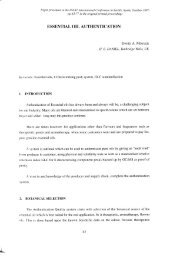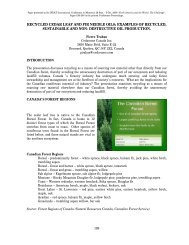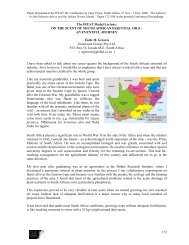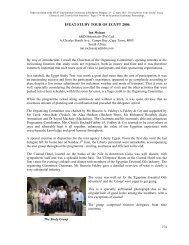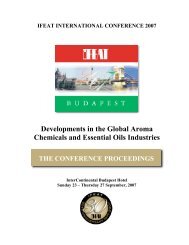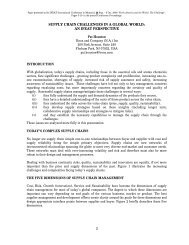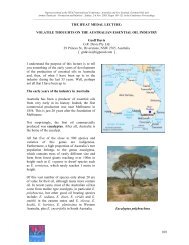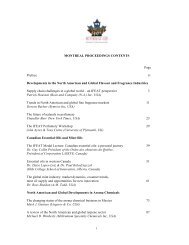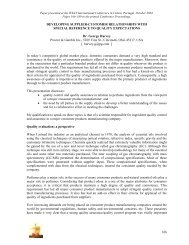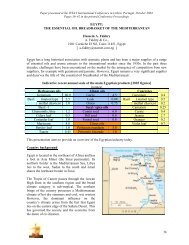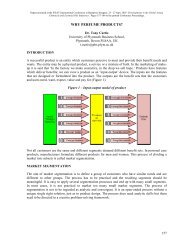THE AUSTRALIAN EUCALYPTUS OIL INDUSTRY - IFEAT
THE AUSTRALIAN EUCALYPTUS OIL INDUSTRY - IFEAT
THE AUSTRALIAN EUCALYPTUS OIL INDUSTRY - IFEAT
- No tags were found...
You also want an ePaper? Increase the reach of your titles
YUMPU automatically turns print PDFs into web optimized ePapers that Google loves.
The two main species exploited for oil production outside Australia are E. globulus (cineole rich oiltype) and E. citriodora (citronellal rich oil type).Two other species that have been significant minor commercial sources of cineole rich oils are E.smithii and E.radiata.E. globulus E. smithii E. radiataThe Australian Eucalyptus Oil IndustryOriginsThe Australian industry wasestablished 150 years ago byJoseph Bosisto, who utilised theoil to manufacture and market arange of medicinal products.From modest beginnings,eucalyptus oil gradually grew tobecome a significant ruralindustry. Production came tofocus on the cineole-type (aka‘medicinal eucalyptus’) oil, Joseph Bosisto Advertisement, ca. 1890which was widely used as anatural medicine and manyother household applications,such as a natural solvent.Along the way, cineole typeeucalyptus oil came to beperceived worldwide as theEssence of Australia.19
The industry over 1920-2000Production and exports of Australian eucalyptus oil grew to some 1,000 tonnes annually in the 1940sand this consisted largely of the cineole (‘medicinal’) oil type. However, a rapid decline occurred afterWorld War II due to competition from other origins of cineole rich oils and the introduction of newmedicines, such as antibiotics.Australian Production of Eucalyptus Oil1920 - 200012001000Tonnes80060040020001920 1930 1940 1950 1960 1970 1980 1990 2000In recent years, the total annual production of eucalyptus oils in Australia has averaged around 120tonnes. The bulk has remained cineole type oil, predominantly derived from E. polybractea and withtwo main producers.There are a number of small specialty oil producers around Australia who harvest a number of othertypes of eucalyptus oils. These mostly cater to the local tourist markets or supply to variousaromatherapy and essential oil wholesalers. Oils supplied include those derived from E. radiata, E.viridis, E. cneorifolia, and E. dives. Also, production from E.viminalis (the Koala tree) is possible inthe future.20
Recent Annual Production of Eucalyptus Oils by Species in AustraliaSpecies TonnesE. polybractea 105E. radiata 10E. viridis 2E. cneorifolia 1E. dives 2Others 1Total 121* * Variable from year to year; weather dependentIt should be noted that, unlike China and Brazil, production of the citronellal rich oil from E.citriodora (recently reclassified as Corymbia citriodora) has never been significant in Australia. Thereason is that the economics of production are unattractive on a monoculture plantation system inAustralia, where the species is susceptible to native pest and disease problems.Developments with cineole (‘medicinal’) oil productionModernisation of production methods, 1960s to 2000The traditional means of obtaining distillation feedstock in Australia was manual harvesting of wildtrees. This system had much intrinsic inefficiency that resulted in poor cost competitiveness withoverseas producers who employed eucalyptus plantations and benefited from lower labour costs. Bythe 1960s, it became apparent that to survive, it would be necessary to modernise the Australianindustry.The principal actors in modernising the Australian eucalyptus oil industry were two companies: GRDavis & Co in New South Wales and Felton Grimwade & Bickford P/L in Victoria. Initially, theyacted to preserve the knowledge gained over 120 years and then set about reconstructing andrebuilding the industry for the future.Their first step was the establishment of plantations of the Blue Mallee (E. polybractea) at WestWyalong, NSW and at Inglewood, Victoria. In the 1970s, they introduced mechanical harvesting offrom their plantations and, subsequently, investigated technologies for high productivity in all areas ofoperations.21
Mallee plantationsMechanical harvesting at Inglewood, VictoriaAt the same time, both companies commenced to import crude, cineole type eucalyptus oil from otherproducers scattered around the world for further processing and to re-export the rectified oil and otheradded-value products.Over the past 20 years, GR Davis and Felton Grimwade & Bickford have continued to invest heavilyin R&D in the search for ideas and technologies that would assist redevelop the Australian industry forthe future.In the 1990’s, they were joined in this quest by farmers and the Western Australia Department ofConservation & Land Management (CALM). The interest of the new collaborators arose from theneed to research methods to control salinity that is affecting or potentially threatening millions ofhectares of arable agricultural land in the Western Australia wheat belt. This initiative has led to whatis called ‘The Eucalyptus Revolution’.Recent developments: Eucalyptus oil and the dry land salinity problemPrior to European settlement in Australia, approximately 300,000 aboriginal people lived in relativeharmony with Nature, although their activities had caused some impact on the flora and fauna oversuccessive millennia. However, the 200+ years of European settlement have led to serious degradationof the natural environment.Today, Australia has nearly 20 million people who are placing major stresses on a very old fragileenvironment. As a consequence Australia is confronting a number of environmental problems.Some of the key issues requiring significant solutions are:• Dryland salinity and land management• Water and water quality• Re-afforestation• Control of introduced weeds and feral animals• Greenhouse gas emissions & global warningSeveral of these issues are closely linked and perhaps, as should be expected, the solution exists in ourown backyard.22
Dryland salinity is the gradual rising to the surface of salt that pollutes the soil and kills off all treesand plants. This in turn eliminates most insects, birds and animals. Left untreated the affected landturns in to unusable wasteland.The effects of dryland salinitySalinity problemareas in AustraliaThe salinity problem is most obvious in Western Australia particularly in its wheat belt. This areacovers some 15 million hectares. According to the Australian Bureau of Statistics:• 1.24 million ha have been affected already and around 6 million ha is under direct threat.• Up to 30% of the wheat belt will be affected in the next 30 – 50 years if nothing is done.New South Wales and Victoria also have emerging salinity problems, especially in the RiverMurray/Darling Basin.With their incomes under threat, farmers need to find a productive alternative crop - one that is alsocomplementary to their existing farming activities.A perceived solution to the problem is to plant eucalypts:• If done in the right way and places, then it is possible to start achieving salinity control,23
• plus with the mallee type eucalypts, some of which are reasonably salt tolerant, theplantings can offer a commercial return to the farmers.In addition, large-scale eucalypt plantings will go a long way to assist re–afforesting a country that hasseen its native forests reduced by 66% in the past 200 years. Large areas of forest help improve waterquality. They help act as giant sponges to soak up excess water and lower the water table allowing thesalt to be washed well below the surface.Since the plantings will be harvested every couple of years, the mallees will also help removesignificant amounts of carbon dioxide from the atmosphere. This will help offset greenhouseemissions and, also, will gain eligibility to carbon credits because of their newly established foreststatus.The current situation in Western AustraliaIn the Western Australia wheat belt:• almost 10,000 ha of mallee species of oil bearingeucalypts have been planted to date, and• 20 million trees are ready for harvesting.The trees planted include eucalypts indigenous to WesternAustralia and introduced E. polybractea from the easternstates.Planting of another 4 million trees is scheduled for 2004.New, semi-automated planting equipment is being used to plant the mallees and techniques have beendevised to maximise survival in the harsh climate. Fully automated precision planting equipment willbe used for planting in 2004. This should gradually allow planting of seedlings to reach up to 400,000per day, approximately 100 ha per day.Semi-automated plantingThe mallees are integrated on the farms in a way that enables easy mechanical harvesting. The firstharvest takes place 3 to 4 years after planting and then harvesting will be repeated every 1 to 2 yearsfor decades. The predicted yield is around 200kg per ha of high-grade oil, containing 85%(+) cineole.24
Will the additional supply from Australia affect the world market? We expect the increased supply tohave a minimal effect on the market. The supply in any significant quantity will take several years toachieve. The oil will be complementary to E. globulus rather than being a direct competitor. The focusfor Australia will be on establishing new markets and expanding consumer and trade usage ofeucalyptus oil around the world. Most of the output in the short term will not be aimed at thecommodity markets.Also much research within our industry and by Australian government funded bodies, such as CSIRO,is being directed at a number of new areas. The main target areas are where eucalyptus oil is notcurrently used, including eucalyptus oil as a replacement solvent or chemical substitute for productsthat are deemed in the longer term environmentally unsafe or potentially hazardous to humans oranimals.These types of applications will only be available when eucalyptus oil production achieves far greatervolumes and where the economic cost of production is low enough to safely allow a switch to occur.Many of these applications are in non-pharmaceutical areas, unlike the current main market for highgradecineole.The Full CircleIt is the long-term aim of the Australian eucalyptus oil industry to at least double the world supply ofcineole-rich oils and then to expand production from this point in to new areas. With the future growthof the world economy over the next decade and the substantial awareness of the need for improvedenvironmental and hygiene levels within all countries, we perceive that it is imperative to developadditional supplies of eucalyptus oil to meet future demand.After 30 years of hard work, the dream that sustained the Felton Grimwade & Bickford and GR Daviscompanies is being realised. While not setting out to be conservationists or environmentalists, a largepart of the groundwork has been laid for the health and well being of our Australian environment inthe future. Indeed, The environmental wheel has turned full circle and the Australian eucalyptusindustry is well placed to survive and grow for the next 150 years. And in this process, our eucalyptsare going to play a major role in the restoration and revegetation of the Australian continent.Peter Abbott, has been involved in the Australian eucalyptus oilindustry for 30 years. He is Chairman of Felton Grimwade & BickfordPty Ltd, which produces eucalyptus oil and manufactures a range ofeucalyptus oil and eucalyptus-based products for the domestic andexport markets.Colin Abbott, the son of Peter Abbott, and has been Felton Grimwade &Bickford’s Marketing Director for 12 years and the Export Director for5 years.27
AcknowledgementsThe authors wish to gratefully acknowledge the assistance of the following individuals in thepreparation of this paper:Tegan Abbott - FGB P/LRichard Davis - GR Davis P/LRic Collins - Euco LtdColin Stuckley - Enecon P/LAdrian Chegwidden - Western Power CorpRobert Jarman - Bronson & Jacobs P/LBotany Department -The University of MelbourneBibliographyA Field Guide to Eucalypts, Volume 1, Brooker & Kleinig, 1983CSIRO, 1999Australian Bureau of Statistics Salinity Survey, Dec. 200228



